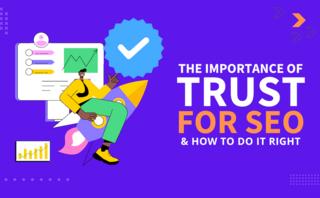177 notes tagged as ["seo"]
Filter your results by choosing one or more tags below or type your query in the search field above.
-

The industry is turning to AI to better understand the technology itself, all with the hope of capturing consumer attention. Consumers are increasingly using AI chatbots for shopping recommendations. The retail industry is working to catch up on generative AI as the technology evolves at a rapid pace. While plenty of companies are using it to drive efficiency, it’s also presented a change to how consumers discover new products.
-

Everyone’s talking about “AI search” ( AI SEO, GEO, AEO, or whatever you call it) – and everyone’s convinced they’re right. Some say SEO is dead. Others say nothing’s really changed (“it’s just SEO”). The truth? Search is evolving fast, but SEO fundamentals still matter.
What’s shifting is where people discover information – and how machines decide what to trust. Here are a few myths worth retiring.
-

Nearly 90% of businesses are worried about losing organic visibility as AI transforms how people find information, according to a new survey by Ann Smarty.
Why we care. The shift from search results to AI-generated answers seems to be happening faster than many expected, threatening the foundation of how companies are found online and drive sales. AI is changing the customer journey and forcing an SEO evolution.
-
You are currently enjoying the free trial mode which gives only back 3 results for each of your searches.
Click on Reset Search Tags to try another search.
Free NewsletterOnly paid members can get full access to the most recent content, create their own tags & personal folders, assign search results to specific projects and much more… all of this for less than 99c a day.
-

The way consumers discover and interact with brands is fundamentally shifting
For decades, search engine optimization (SEO) has been the cornerstone of organic discovery and the primary mechanism through which users found and returned to digital experiences. Brands have created entire marketing programs around these rules — acquiring traffic, guiding journeys, and measuring it all in clicks. But with the rise of generative AI-powered tools like ChatGPT and Google AI Overview, the way consumers discover and interact with brands is fundamentally shifting.
-

From SEO to GEO: a new era of search visibility
Master the transition from traditional SEO to Generative Engine Optimization to stay ahead in the AI-driven search landscape. This comprehensive guide reveals how to optimize your content for LLMs and AI search engines, ensuring your brand maintains visibility and stays competitive.
-

Ecommerce content strategy in the age of AI Overviews
Traditional ecommerce SEO strategies are being upended. Google’s AI overviews, declining click-through rates, and hyper-personalized search results are reshaping conversion paths, forcing ecommerce brands to rethink how they drive visibility, authority, and conversions. To stay competitive, ecommerce businesses must pivot toward more dynamic, AI-aware content strategies. Ultimately, success will favor brands that embrace change, publish quality content, and proactively position themselves for discoverability across both traditional and emerging digital surfaces
-

2026 Forrester budget planning guide
Pressure is on to boost CX performance, and leaders are turning to AI to get there. In fact, 39% plan to increase CX investments above inflation in the next year. More budget for the right tools fuels more efficient operations, faster resolutions, and experiences that keep customers coming back.
Forrester’s “Budget Planning Guide 2026: Customer Experience,” shows you where to focus for maximum impact. Compare your budget strategy with peers and discover where AI, data, and CX investments deliver the highest return.
-

SEO is dead. Long live GEO?
As personal AIs and chatbots transform search behavior, WPP’s chief AI officer, Dr Daniel Hulme, explains why marketers must now optimize for what AI “knows” – not just what people type. “Reports of my death are greatly exaggerated,” Mark Twain famously wrote to a newspaper that had (rather prematurely) published his obituary.
The same could be said of SEO.
While some loudly decry its demise, the reality is more nuanced. SEO will remain a crucial tool, but its dominance is ending.
-

How brands and retailers are preparing for GEO, 'the future of SEO'
After years of retooling their businesses for search engines, brand and retail leaders say they’re getting ready for a new frontier: GEO. The term, which means generative engine optimization, refers to optimizing web content to show up in results from AI-driven search platforms, like ChatGPT or Google Gemini. It’s a new way for brands to stand out and reach customers, especially considering thatnearly 60% of U.S. consumers have used a generative AI tool for help with online shopping, per an August 2025 survey from Omnisend. If a customer asks an AI engine about buying lip gloss or a T-shirt, the relevant brands want to make sure they show up.
-

Building trust for SEO: Why it matters & how to do it
Trust is the foundation of strong search engine visibility. Google wants to recommend sites that are credible, useful, and safe. The user experience matters, too. Your site’s design, speed, and ease of navigation play just as big a role as the words on the page. If visitors bounce because your site is slow or frustrating to use, Google takes it as a sign you can’t be trusted.
Let’s explore why trust matters for SEO and the steps you can take to build it.
-

Low-budget SEO strategies that actually work
Getting your business noticed online can feel like an uphill climb, especially when your budget is tight. A lot of people assume that unless you’re spending a hefty amount on SEO, there’s no point in even trying. That idea has stopped plenty of deserving businesses from getting the visibility they need to grow. But here’s the truth: SEO doesn’t have to drain your wallet to be effective. With a little focus and understanding, affordable SEO can pull real weight and give businesses a strong online presence.